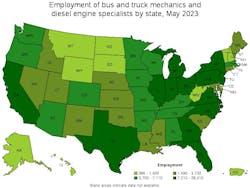Building better tech recruiting with four healthy habits
Though there’s still “a really big need for technicians across the country,” the technician shortage is not hitting all shops and fleets the same way, according to Jay Goninen, co-founder and president of WrenchWay. He has seen a shift across the country.
“Not as many shops are as crazy desperate as they were for technicians just even back a year ago,” Goninen said on a virtual discussion hosted by Fullbay in June. “I think the change is more geographically driven, depending on where you're at and your ability to get out in front of good technicians.”
The most recent occupational employment by location data from the Bureau of Labor Statistics supports this as well. One factor is of course population, which determines how many bus and truck technicians and diesel engine specialists will be needed. For instance, Wyoming currently employs 940 of such techs, while Texas has over 28,000. The other thing to look at is location quotient (LQ), or the ratio of technicians employed in a given state compared to the nationwide average. Colorado features a lower concentration (LQ of .77) while Texas has a higher one (LQ of 1.12).
Regions with a lower LQ will face more competition for techs and thus must put more emphasis on efficient hiring practices, but even shops in areas in areas with high LQs should remain vigilant for talented technicians, as retaining your best techs is never assured.
“Always be hiring—because you never know,” said Jennifer Wilson, co-owner and CEO of California-based Inland Empire Fleet Maintenance at Fullbay's Diesel Connect Conference in May. “As much as we try to treat our employees like our own, sometimes candidates just walk out the door for a buck.”
But the hiring process can be a full-time job on its own, and one that shop managers don’t have the time for between day-to-day operations. To decrease that work, shops and fleets should ensure their processes are aligned before they need to hire a new tech.
“Build healthy habits along the way; it's going to make your life so much easier for recruiting and retention,” said Mark Wilson, CEO of WrenchWay on a June educational session. “And then instead of being desperate, when someone does leave, or someone gets sick, or someone gets injured, you're better prepared.”
Based on recent interviews and webinars, here are four healthy habits that should be baked into your hiring strategy.
1: Plan for recruitment
One of the easiest ways to prepare for the technician shortage is to make sure shop recruitment is a priority, Goninen said.
“And when I say prioritize, that means putting a meeting on a calendar,” he explained.
Timing matters. This meeting can’t be an afterthought at the end of a long operations gathering. It needs to be a separate time where leadership considers their hiring sources and what action items they need to pursue for the month.
From this meeting, shops need to be “able to have people that you can call when you do eventually need a technician, if you don't need one right now,” Goninen noted. “Making sure that you know where those people are at and that you have their contact information all starts with that monthly meeting.”
A few other good topics for this monthly meeting include:
- Which local technical and high schools to partner with
- Who is slated to retire and when
- How to manage your online presence to engage with potential hires
- What needs to be changed/updated on your site’s “careers/hiring” page
You should also take into account what recently hired technicians said drew them to your operation. If there’s a clear favorite, fish more from that hiring stream.
2: Routinely maintain your careers page
It’s 2024, so you should have an area on your site for potential applicants to communicate with your company. That is not always the case. Goninen stated that when he checks clients’ websites, he often doesn’t find a careers page at all.
That works out for WrenchWay, which connects shops to techs.
“A lot of our clients will use their WrenchWay page as a careers tab because they can keep it accurate and up to date and don't have to go through some web developer to make changes,” the WrenchWay president said.
Social networks such LinkedIn or Facebook can also be cost-effective alternatives to a dedicated page on your website.
But having a page is just the start. It’s not a “set it and forget it” type thing; it’s an area for continuous fine-tuning and continuous improvement. Routinely verify your careers page is easy to access and understand. And for larger companies, make sure language is tailored to the specific job, and not copy and pasted from another role.
Furthermore, does the hiring page list current job openings and benefits? Does it show images that put the shop in the best light? This is likely an applicant’s first impression of where they could be spending 60+ hours a week for ideally several years. Make it a good one.
3: Test drive the hiring process
Another way to improve recruitment is by going through the process yourself on a quarterly basis.
“I encourage people to go and try to apply to their own job,” Goninen explained. “See how hard it is to go through that process and tear yourself apart, because the more you can do that, the better the experience for that technician.”
This means making sure the application submission process works well and isn’t repetitive, and that it goes to the current person in charge of hiring. You can also see how long it takes for that hiring manager to respond back. Additionally, make sure that your hiring process is suited to the applicants you want.
4: Expedite your hiring response
Finally, make sure that you’re ready to quickly respond to applicants when you need to.
“You can't get back to them after two or three days anymore; you have to get back to them as soon as humanly possible,” Goninen stated. “So, maybe you're putting in a rule that by the end of each day, if there's applicants, you're going to call those people before you leave that day.”
This could also mean being ready to let go of certain application expectations to find the right fit. Goninen noted that some technicians might struggle at building a resume, but that this doesn’t mean they shouldn’t be equally considered for their skills and attitude.
“Being able to get past that, make the call, and just get to know them a little bit [is critical],” he noted. “Who knows, that might be a future tech down the road that needs to get some more experience before they come to work for you, but they might want to come back.”
About the Author

Alex Keenan
Alex Keenan is an Associate Editor for Fleet Maintenance magazine. She has written on a variety of topics for the past several years and recently joined the transportation industry, reviewing content covering technician challenges and breaking industry news. She holds a bachelor's degree in English from Colorado State University in Fort Collins, Colorado.

